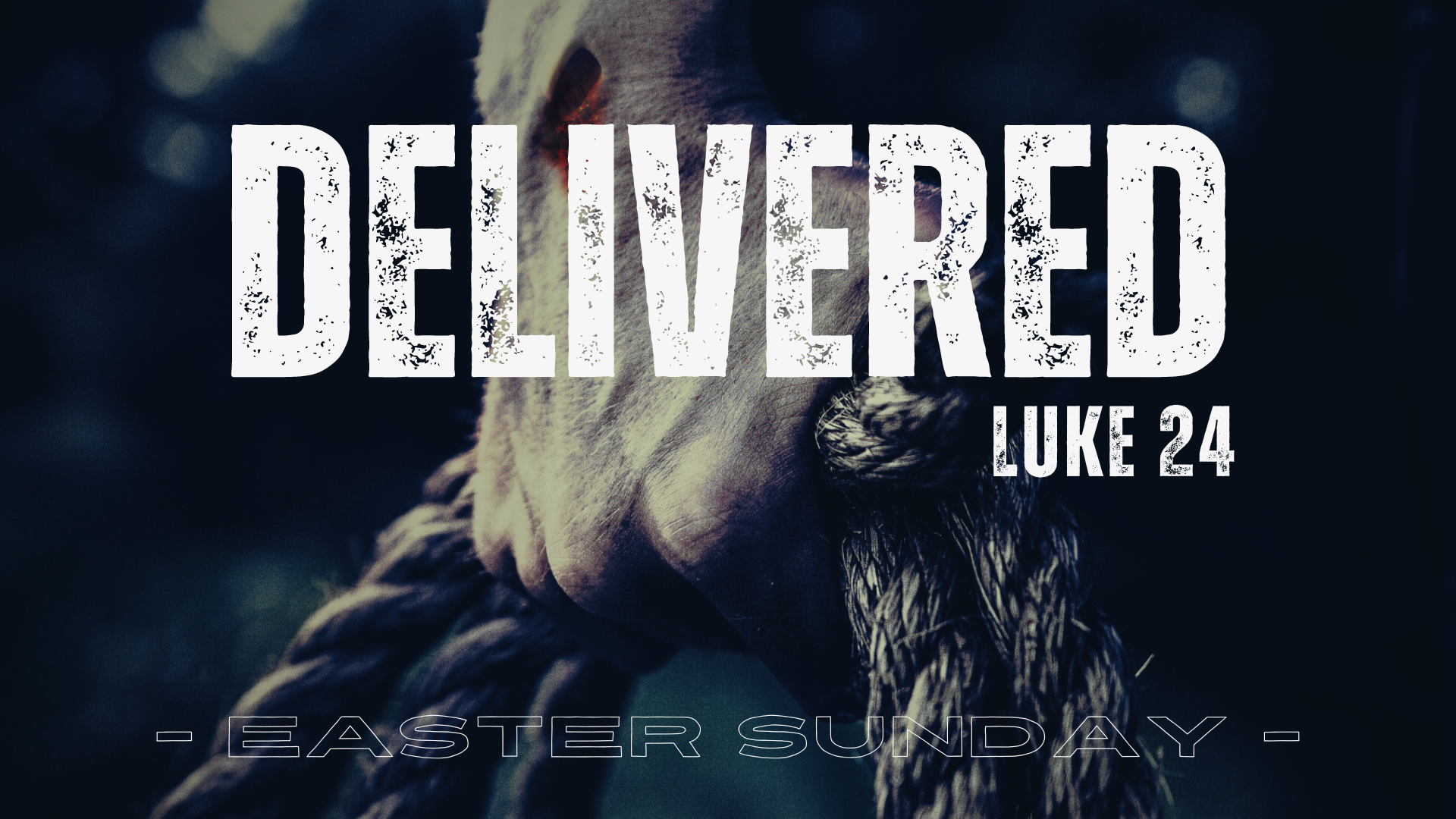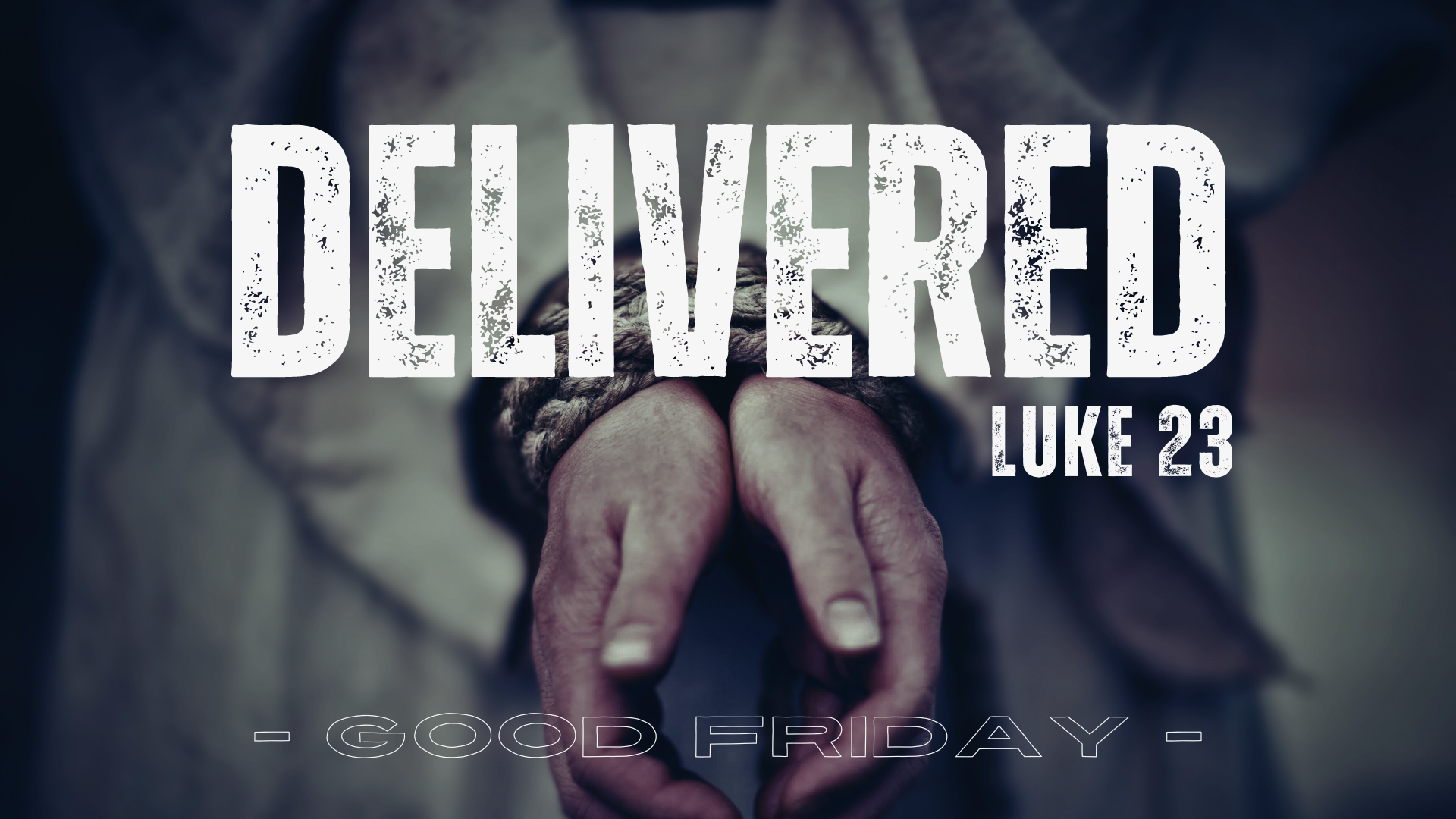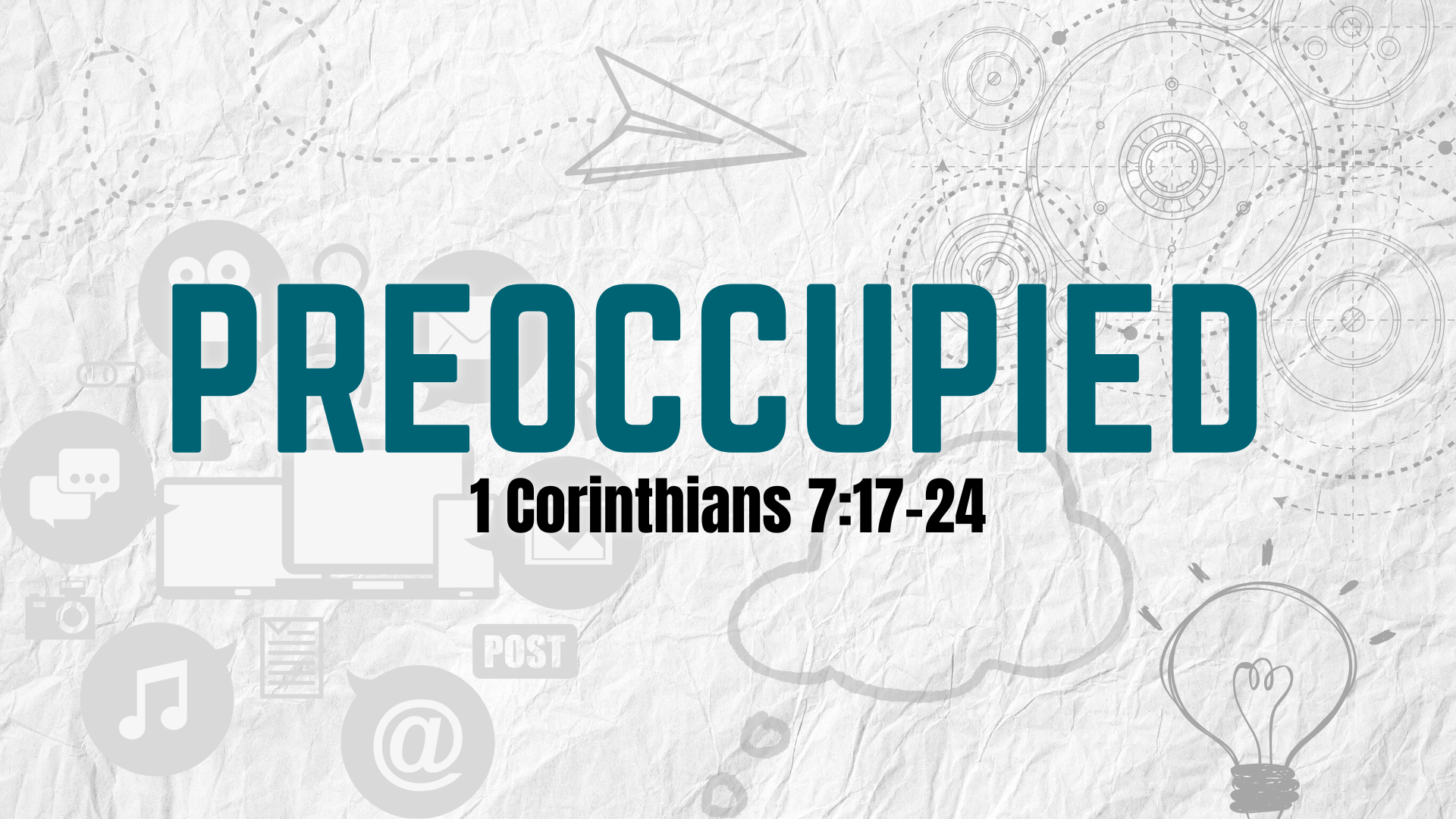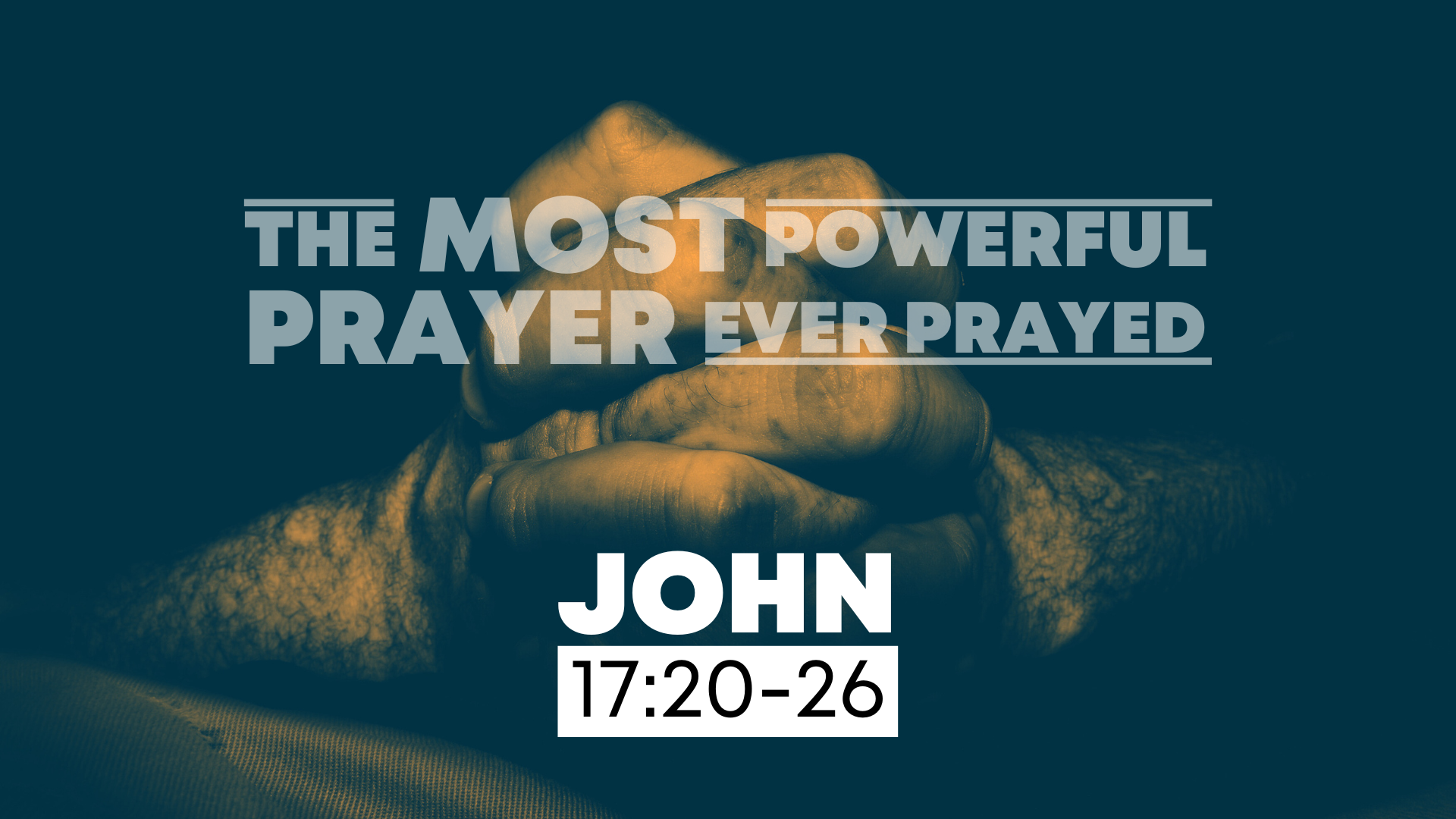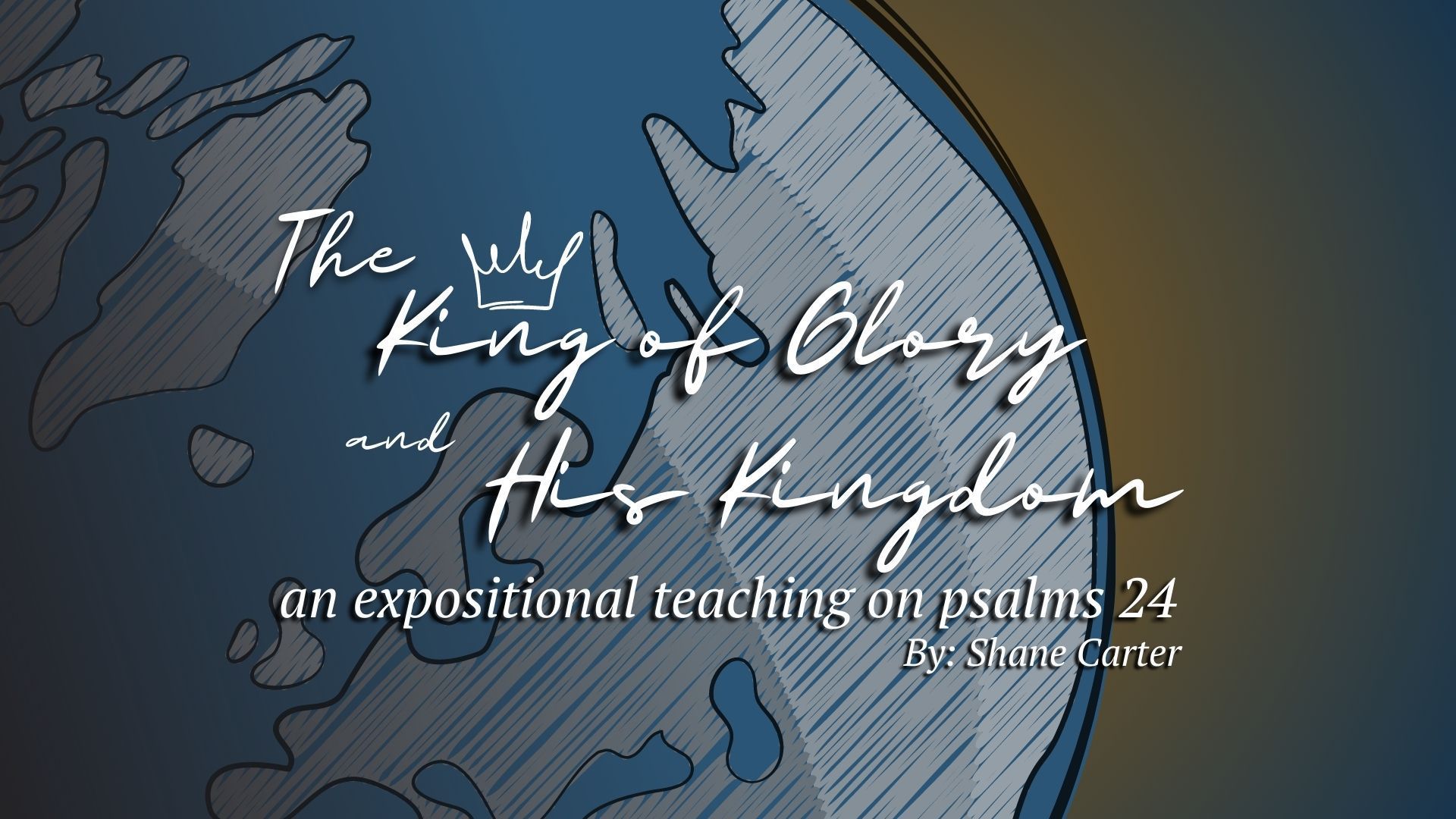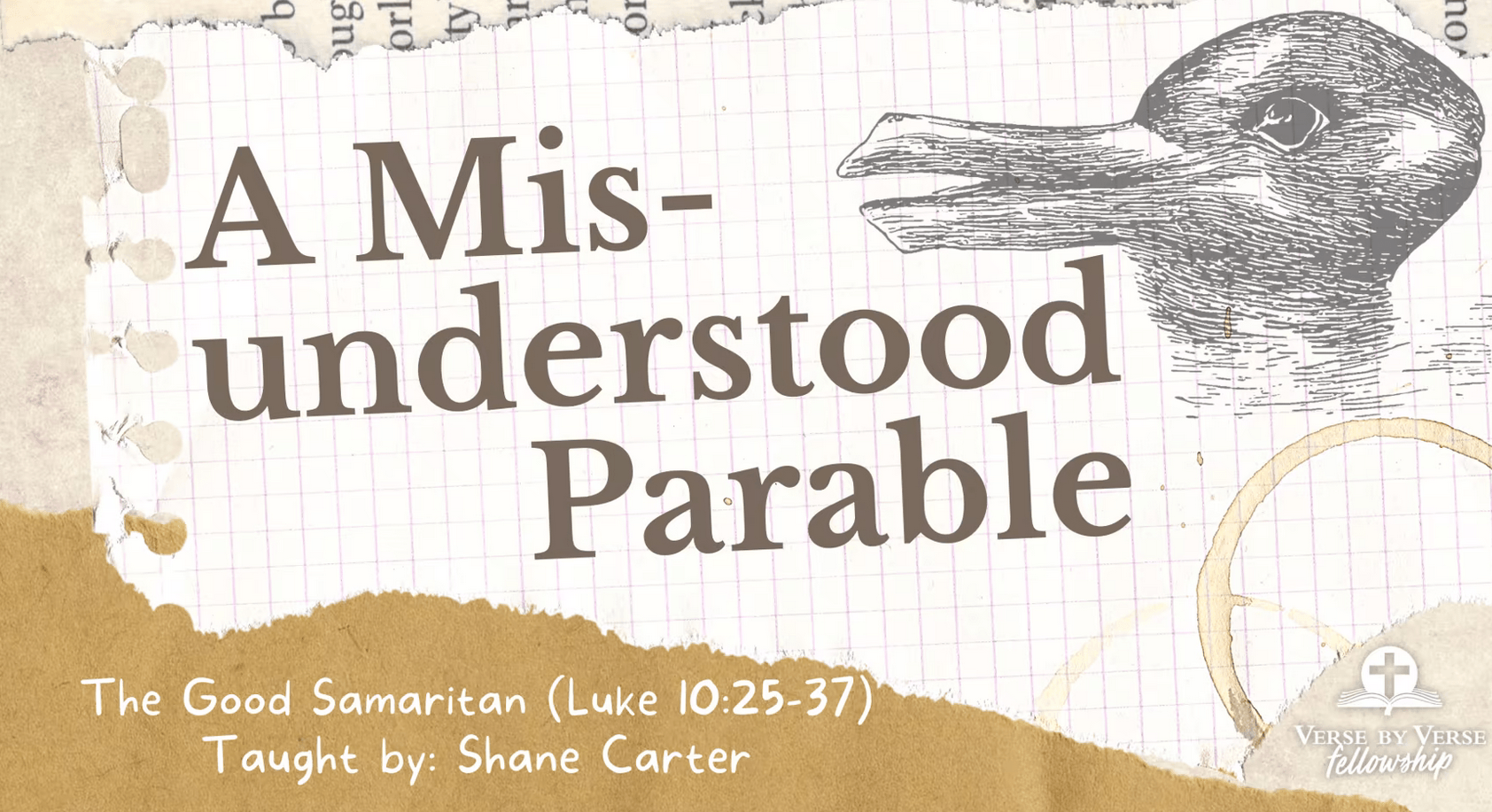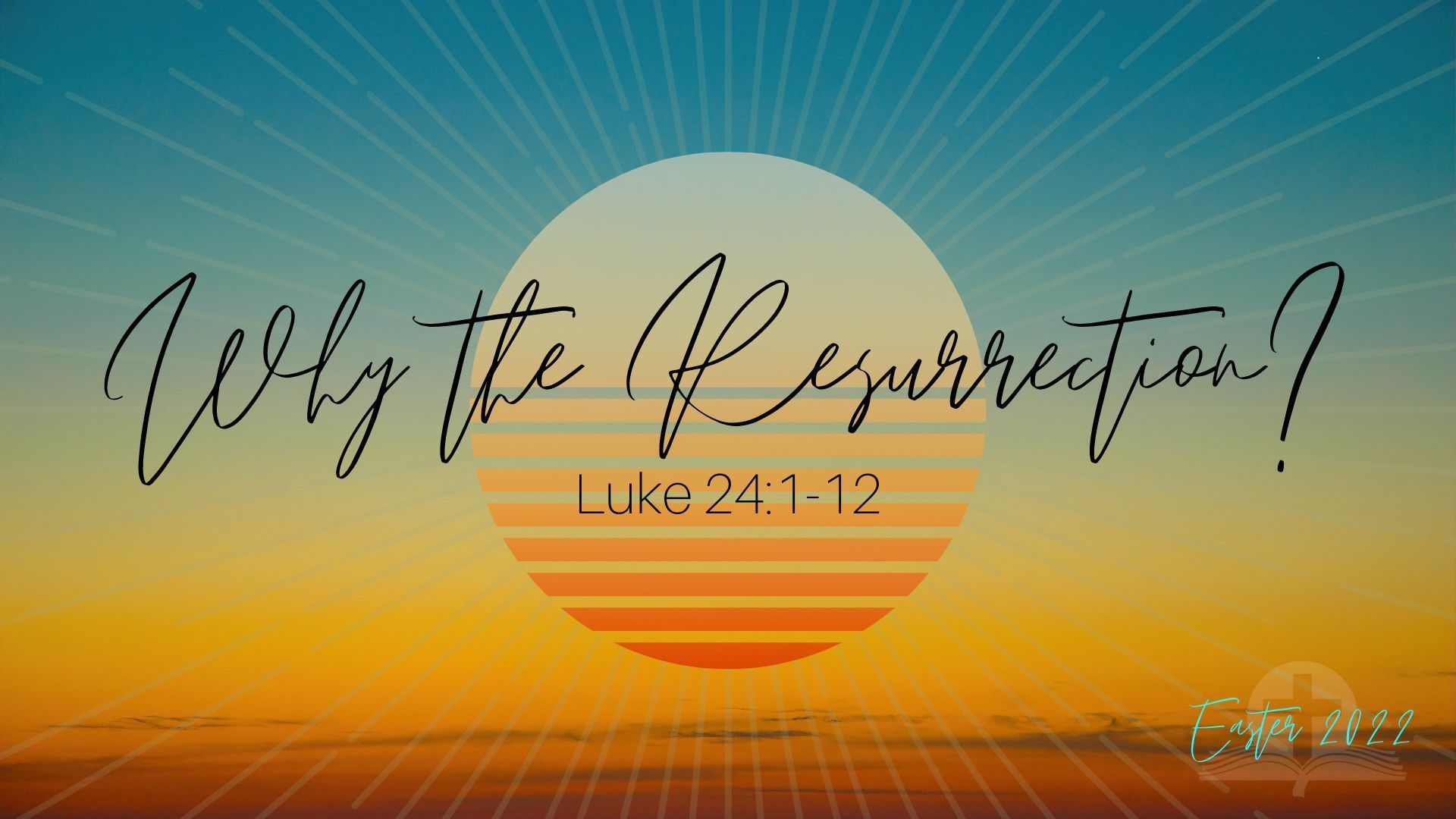INFO
MINISTRIES
TEACHINGS
CONNECT
MANUSCRIPT
Introduction: Amen. Church you may be seated. And as you are being seated, go ahead and take your Bibles with me and turn to the Gospel of John, chapter 20. And as you are turning there, let me just start with a depressing observation this Easter Sunday 2023. Easter Sunday is such a wonderful time of celebration. But let me throw some cold water on this celebration this morning with an observation. By the end of this century, in the year 2100, every single person in this room will, most likely, be dead. Maybe 10% of our church as presently constituted will still be alive. Most of us will be long gone.
I heard a report recently that the dangerous “asteroid 99942 Apophis” will thankfully not be hitting the earth in the next century or so.1 But supposedly it will miss our planet by 20,000 miles in the year 2029. 20,000 miles! Can I just be straight with you for a moment? ... that’s a close shave! We will barely escape planetary destruction and devastation. Thank goodness that God is in control over the universe, because we surely aren’t.
But let me just say this as well, you are still going to die in the next 100 years. Every one of us will die, unless Jesus comes back before then! If there’s anything that this era of COVID-19 has taught us, it’s that we are not as strong and indestructible as we think we are. Death hovers over all of us. What are we going to do about that? Happy Easter everybody!
-----------------------------------------------------------------------------------------
Well as depressing as that is, there was actually a moment in human history that was even more dire.2 There was a moment in human history when eternal death hovered over all of us. It was in John 19, when Christ Jesus, the Son of God, was arrested, beaten, convicted, flogged, brutalized, and crucified. Jesus was forced to carry a cross outside the city of Jerusalem, and there he was put to death. And afterwards he was buried in Joseph’s tomb. At that moment, eternity hung in the balance. Those three days that Jesus lay dead in the tomb were the darkest days in human history.3 And if John 19 was all that was written… in other words, if there was no John 20… then there would be no reason for us to be at church this morning.4 There would be no reason for Easter celebration.5
The title of our message today is “Resurrection Restoration.” And I want to look at how Jesus’s resurrection in John 20 is restorative for us. And I want to look at some specific characters in John’s resurrection story to see how Jesus helps us to deal with the reality of death. I want to look at Mary Magdalene. I want to look at Jesus’s disciples as a group. I want to look particularly too at Thomas, one of Jesus’s disciples. And then at the end of John 20, John breaks the fourth wall and looks directly at his readers. John speaks directly to us. And I want us to end there.
-----------------------------------------------------------------------------------------
But let’s start with Mary Magdalene. Write this down as #1 in your notes.
1 See the “World and Everything In It” podcast for 03-31-21. Transcript can be read here: https://wng.org/podcasts/kicker-the dangerous-asteroid-tracker-1617559728. See also the NASA article “NASA Analysis: Earth Is Safe From Asteroid Apophis for 100- Plus Years”: https://www.nasa.gov/feature/jpl/nasa-analysis-earth-is-safe-from-asteroid-apophis-for-100-plus-years and the following informational video entitled “What if Apophis Hits Us in 2029?”: https://www.youtube.com/watch?v=NlJQ7MusKhI 2 D. A. Carson, The Gospel according to John, PNTC (Grand Rapids: Eerdmans, 1991), 631: “For John, nothing could be more disastrous than to consider the cross in isolation from the resurrection, for nothing is more certain in his mind than that the cross is the route Jesus took to return to his Father (14:28-31; 20:17), that the ultimate glorification of the Son with the Father is accomplished through the paradoxical glorification on the cross (12:23-28).”
3Jesus was placed in the tomb before dusk on Friday. So that’s possibly 5-6 hours on Friday, 24 hours on Saturday, and a few more hours on Sunday. That’s a total of about 30-36 hours between his death and resurrection. By Jewish reckoning, that was three days— part of Friday, Saturday, and part of Sunday.
4 C. S. Lewis, Miracles (New York: Macmillan, 1947), 112: “In the Christian story, God descends to re-ascend. He comes down, down from the heights of absolute being into time and space, down into humanity, down to the very roots and seed bed of the humanity which He Himself created. But He goes down to come up again and bring ruined sinners up with Him.” 5 Craig S. Keener, IVPBBCNT (Downers Grove: InterVarsity Press, 1993), Jn 20:1-10: “Those modern critical scholars who have suggested that the original disciples meant only that they had a spiritual experience but did not claim that Jesus rose bodily read their own modern culture into the New Testament: “resurrection” meant bodily resurrection and nothing else, and no one would have persecuted the disciples for claiming that they had had merely a spiritual experience. Mere belief in ghosts and apparitions was widespread and would not have gotten them in trouble with anyone.”
Jesus’s resurrection restores…
1) hope to the brokenhearted (Mary Magdalene - 20:1-18)
At the beginning of John 20, we find Mary Magdalene distraught and traveling to the tomb of Jesus.6 1 Now on the first day of the week [i.e. Sunday7] Mary Magdalene8came to the tomb early, while it was still dark,9 and saw that the stone had been taken away10 from the tomb.11
Now just to be clear, the day of the week here is Sunday.12 That’s the first day of the week, and the first Easter Sunday.13 The Jews didn’t give names to the seven days of the week, they gave them numbers. And the first day of the week was the first day after Sabbath.14 So this is Sunday morning nearly 2,000 years ago. And instead of finding a massive boulder in front of Jesus’s tomb, she finds the stone removed.15 And instead of investigating further, Mary just bolts out of there.
2So she ran and went to Simon Peter and the other disciple, the one whom Jesus loved [a.k.a. John the Apostle, the author of this book], and said to them, “They have taken the Lord out of the tomb, and we do not know where they have laid him.” You can sense the fear and the panic in her voice as she says this. “They have taken the Lord out of the tomb!”16 Now notice a few things here. First of all, Mary does not think that Jesus has risen from the dead. That’s not her concern here. Even though Jesus told Mary and the disciples that he would in fact be raised from the dead!17 He told them, but it didn’t register with them.
6 Much has been made of the ways that the resurrection appearances differ between the gospels. One issue, the issue of whether or not Mary Magdalene was alone at the tomb is addressed by Carson, John, PNTC, 632: “Some of the alleged discrepancies are at the trivial level. John is criticized for having Mary come to the tomb alone, even though she says ‘we [plural] don’t know where they have put him!’ (20:2); alternatively, he is criticized for mentioning only Mary of Magdala when Mark (16:1) adds Mary the mother of James, and Salome—while Matthew (28:1) says it was Mary Magdalene and the other Mary, and Luke (24:10) specifies Mary Magdalene, Mary the mother of James, Joanna, and others who were with them. But there are more than a score of passages in the Gospels where one Evangelist reports so-and-so-many people, and a parallel report adds one or two more, or mentions only one person… Only the assumptions scholars make about the nature of the descent of tradition, coupled with peculiarly modern and Western notions of precise reportage, could discern any difficulty in such variables.” For a possible harmonization of Jesus’s resurrection appearances recorded in the Gospels, see Craig Blomberg, Jesus and the Gospels (Nashville: B&H Publishing, 2009), 413ff. Or see the summary at this website: https://aaronshaf.wordpress.com/2017/04/16/resurrection-events/.
7 Carson, John, PNTC, 635: “It is remarkable that all four Gospels (cf. Mt. 28:1; Mk. 16:2; Lk. 24:1) introduce their respective resurrection accounts by specifying the first day of the week, rather than ‘the third day’ after the crucifixion (cf. 1 Cor. 15:3, 4), despite Jesus’ passion predictions (Mk. 8:31 par.). The reason is disputed, but it may have to do with the desire to present the resurrection of Jesus as the beginning of something new.”
8 Morris, Luke, TNTC, 353: “Mary Magdalene, the first to see the risen Lord (cf. Mark 16:9), is mentioned in each of the four Gospels in the resurrection narrative.” See Darrell L. Bock, Luke: 9:51-24:53, vol. 2, BECNT (Grand Rapids: Baker Academic, 1996), 1885-8 and his four options for harmonizing the accounts of Mary Magdalene in the Gospels.
9 Carson, John, PNTC, 635: “[O]ne is tempted to think that John emphasizes the darkness of the dawn because he is still using light/darkness symbolism.” Light/dark symbolism is prominent throughout Johannine literature.
10 Robert H. Mounce, “John,” in The Expositor’s Bible Commentary: Luke-Acts (Revised Edition), ed. Tremper Longman III & Garland, David E., vol. 10 (Grand Rapids: Zondervan, 2007), 643: “The Greek ērmenon (‘had been removed’) is a participial form of the verb that means ‘to lift up or remove’ … and in this context suggests a sudden act involving he exercise of force.” 11 Matthew Henry was the first person to call Jesus’s tomb a “borrowed tomb.” See Matthew Henry, Matthew Henry’s Commentary on the Whole Bible: Complete and Unabridged in One Volume (Peabody: Hendrickson, 1994), 1771.
12 Robert H. Stein, Luke, NAC (Nashville: Broadman & Holman Publishers, 1992), 604: “Shortly the first day of the week [i.e. Sunday] replaced the Sabbath [i.e. Saturday] as the main day of worship for the church (cf. Acts 20:7; 1 Cor 16:2; Rev 1:10).” 13 R. Kent Hughes, John: That You May Believe (Wheaton: Crossway, 2000), 460: “Without a doubt, [this day] was the most dramatic day in the history of the world.”
14 This was after resting all day on Saturday in accordance with Jewish practice (cf. Gen 2:3; Ex 20:8-11; Deut 5:12-15). BEDE: “After our Lord had been buried on Friday, the women went away from the tomb and prepared spices and ointments for as long as they were allowed to work. Then they refrained from any activity on the sabbath, in accord with the commandment, as Luke clearly reports. When the sabbath was over, as evening was coming on, one could work again.” Quoted in Arthur A. Just, ed., Luke, ACCS (Downers Grove: InterVarsity Press, 2005), 374.
15 All four Gospels culminate in the resurrection. It is the driving focal point of all four writings. Interestingly the particulars of how Jesus was specifically raised from the dead are not addressed, just the aftereffects. Leon Morris, Luke: An Introduction and Commentary, vol. 3, TNTC (Downers Grove: InterVarsity Press, 1988), 351: “None of the four Gospels describes the resurrection, which in any case no-one saw. But all emphasize its critical importance, though in widely differing ways.” 16 Mounce, “John,” in Luke-Acts, 643: “It is interesting that Mary of Magdala is mentioned only once in the Gospels apart from the crucifixion and empty tomb, yet she becomes the first person to see the risen Lord. In Luke 8:2 Mary is identified as one from whom seven demons had been expelled.”
17 There are three occurrences in Luke where Jesus predicted his death (Luke 9:21-22; 9:43-45; 18:31-34), but in only two of these did he predict his resurrection (9:21-22; 18:31-34). Jesus predicted his death and resurrection three times in Matthew’s Gospel (16:21;
And notice a second thing. Mary says, “we do not know where they have laid him.” What Mary assumes here is the worst. She assumes grave robbers perhaps have taken the body. She assumes that “they,” whoever “they” are (the Jews, the Romans), have laid his lifeless body somewhere. This would be extremely disconcerting for a Jewish person that Jesus’s dead body was touched and moved. And who knows what nefarious purposes “they” might have. Maybe they brought Jesus’s body out in the open to be mocked and ridiculed some more? Maybe the Romans hung his body up to be used as a warning against future insurrectionists? She doesn’t know. But Peter and John are going to find out. So verse 3. 3So Peter went out with the other disciple, and they were going toward the tomb. 4 Both of them were running together, but the other disciple outran Peter and reached the tomb first.
Remember in this day grown Jewish men don’t run. That’s what kids do, not adults. Nevertheless they were running. Like Usain Bolt, they were running. And John, the author of this book, wants to make clear that he smoked Peter in this footrace. Make a note! Why would John record that? Because it really happened! It’s a historical factoid that only an eyewitness would record.
5 And stooping to look in, [John] saw the linen cloths lying there, but he did not go in.
John is cautious. That’s his personality. But Peter… he’s not like that.18
6 Then Simon Peter came, following him, and went into the tomb. He saw the linen cloths lying there, 7 and the face cloth, which had been on Jesus’ head, not lying with the linen cloths but folded up in a place by itself.19
In other words, this is not a crime scene. If Sherlock Holmes were here, he would very quickly point out that no grave robbers had been here to rob the place. And if Jesus had been forcibly moved by the Romans or the Jews, why would they unwrap his dead body? And if they did do that, why would they neatly fold the head cloth.20 Something else is going on here.
8 Then the other disciple [John], who had reached the tomb first, also went in, and he saw and believed;21 9for as yet they did not understand the Scripture, that he must rise from the dead. 10 Then the disciples went back to their homes. Now we’ll talk more about these guys in a moment, but let’s get back to Mary.22 Because typical men that they are, they just took off running for the tomb, went back to their homes, and they didn’t even bother following up with Mary. So in verse 11, we find Mary weeping outside the tomb.23
11 But Mary stood weeping outside the tomb, and as she wept she stooped to look into the tomb. 12 And she saw two angels in white, sitting24 where the body of Jesus had lain, one at the head and one at the feet.25
17:22-23; 20:17-19) and alluded to it a fourth time (26:31-32). See also the parallel accounts in Mark’s Gospel (8:31-33; 9:30-32; 10:32-34). See also two allusions in John’s Gospel (2:19; 16:17).
18 Carson, John, PNTC, 637: “Peter may arrive second but, true to his nature, he impetuously rushed right into the tomb.” 19 Keener, IVPBBCNT, Jn 20:6-7: “Had robbers stolen the body (a rare practice) they would have taken it in its wrappings; had they left the wrappings, they would have left them in disarray. Whoever left them, left them there neatly.”
20 Gerald L. Borchert, John 12-21, vol. 25B, NAC (Nashville: Broadman & Holman Publishers, 2002), 292: “The contemporary thought that they could create a resurrection hoax or experience a joint encounter with some mystical Christ as some have suggested is absurd, given the defeatism that enveloped Jesus’ followers after they realized Jesus was truly dead. The only possibility that crossed Mary’s mind was that the body must have been stolen in clear violation of Jewish burial integrity and of Roman practice.” 21 Mounce, “John,” in Luke-Acts, 644: “What did John believe? Certainly more than the obvious fact that the body of Jesus was no longer there. He saw with the eyes of faith and arrived quickly at the conclusion that Jesus had been raised from the dead. This insight of faith made him the forerunner of all who would be declared ‘blessed’ for believing prior to seeing (cf. v.29).” Likewise Hughes, John, 457 states, “But what did [John] believe? That Jesus was gone? No. He believed the resurrection! John was the first in the world to believe that Christ was alive again.”
22 It is significant in 20:8 that John the Apostle is mentioned as the first person who “believed.” Carson, John, PNTC, 638 says, “Most of the early witnesses came to faith in Jesus as the resurrected Lord not because they could not find his corpse but because they found Christ alive; but John testifies that he came to such faith before he saw Jesus in resurrected form.” Also Borchert, John 12-21, NAC, 295 states, “it is particularly noteworthy that the beloved disciple is the only person in the Gospels who is recognized as having reached a point of believing as the result of seeing the empty tomb… It took the appearances of the risen Lord himself to convince most followers that the resurrection was a reality. The beloved disciple, however, is here viewed as the model for the believing community.”
23 Borchert, John 12-21, NAC, 297: “In a patriarchal society where a woman’s testimony to the resurrection of Jesus would not be valued highly (cf. the way women’s statements were regarded in Luke 24:11, 24-25; Acts 12:15), the length of this story in the evangelist’s selection of materials is rather striking.”
24 Morris, Luke, TNTC, 352-3: “Matthew speaks of one angel who rolled the stone away and also spoke to the women. Mark refers to a young man in a white robe whom they saw after they entered the tomb. John mentions two angels in white who spoke to Mary Magdalene. It is clear that all these refer to angels. The fact that sometimes we hear of one and sometimes of two need not concern us. As many commentators point out, a spokesman is more prominent than his associates and may be referred to without mention of others. Neither should we be greatly concerned that the angels may be sitting (in John) or standing (here), nor that their words are not
By the way, this word for weeping is the Greek work κλαίω. It’s the word that was used of Lazarus’s sister when Lazarus died (John 11:33).26 It indicates strong emotion, bitter weeping, or even wailing.27 13 They said to her, “Woman, why are you weeping?” She said to them, “They have taken away my Lord, and I do not know where they have laid him.”
There’s that “they” again. She doesn’t know who “they” are, but she assumes that “they” have done something awful. And what’s amazing here is that Mary is so struck with grief, it doesn’t even register with her here that she’s talking with angels. You know, typically when angels show up, people hit the deck in trepidation. Mary is oblivious to this, either because she is so overcome with grief, it doesn’t even hit her, or because her eyes are so filled with tears that she can’t see who she’s talking with.
14 Having said this, she turned around and saw Jesus standing,
Hey-oh! There he is! Mystery solved!
but she did not know that it was Jesus.
Man, she is really overcome with grief, isn’t she? She doesn’t recognize Jesus.
15 Jesus said to her, “Woman, why are you weeping?
“There’s no crying in resurrection, Mary.”28 “This is not a time for weeping! It’s a time for rejoicing!” Whom are you seeking?” Supposing him to be the gardener,29 she said to him, “Sir, if you have carried him away, tell me where you have laid him, and I will take him away.”
It’s amazing that she doesn’t recognize Jesus. Again, maybe the tears have so filled up her eyes she can’t see straight. But also there’s this thing in the NT, where whenever Jesus shows up, people recognize him, but they don’t recognize him. Right? It’s him, but he’s different.30 I think that’s because there is continuity and discontinuity with our resurrection bodies. I look forward to that. “It’s Tony, yeah, but he’s different. He’s better than ever!” That’s what I think is going on here with Jesus.31
And then Jesus speaks to her. He says her name. And it must have been in the way he said her name. 16 Jesus said to her, “Mary.” She turned and said to him in Aramaic, “Rabboni!”32 (which means Teacher). Jesus’s resurrection restores hope to the brokenhearted, right? And then,
17 Jesus said to her, “Do not cling to me, for I have not yet ascended to the Father;
Now what I imagine at this point is that Mary grabbed ahold of Jesus and just wouldn’t let go. “I lost you once, Jesus, I’m not losing you again.” And she just gave him the biggest bear-hug that was allowable in
identical in the various accounts. It is hypercriticism that does not allow angels to change their position, and there is no reason for thinking that they spoke once only. Moreover John speaks of them in connection with a different incident. Problems there undoubtedly are, but the chief thing these minor differences tell us is that the accounts are independent.”
25 Mounce, “John,” in Luke-Acts, 645: “Some call attention to the position of the two golden cherubs who face each other from the two ends of the cover of the ark (Ex 25:20). Jesus had died between two criminals (Lk23:33), but his burial place was between two angels.”
26 Lazarus’s sister is also named Mary. She was weeping (κλαίω) along with other Jews. Jesus famously also wept (see John 11:35), but the word used for him was the milder, but still emotion-laden, δακρύω.
27 See κλαίω #1 and #2 in BDAG, William Arndt et al., A Greek-English Lexicon of the New Testament and Other Early Christian Literature (Chicago: University of Chicago Press, 2000), 545. Also see κλαίω in Moisés Silva, ed., NIDNTTE (Grand Rapids: Zondervan, 2014), 683-5: “[κλαίω] is used to express strong emotion, e.g., at parting (Acts 21:13), when thinking of the enemies of Christ (Phil 3:18), when facing death (Mark 5:38; Luke 7:13, 32; John 11:31, 33; Acts 9:39), or generally when encountering affliction (Rom 12:15; 1 Cor 7:30). In the NT the term is not used to express joy.”
28 With reference to the same question asked earlier by the angels, Carson, John, PNTC, 640 says, “The question of the angels, why are you crying?, is not designed to elicit information. It is gentle reproof: by this time Mary should not have been crying.” 29 Keener, IVPBBCNT, Jn 20:15: “Gardeners were at the bottom of the social scale, and a gardener there would have tended to the gardening, not to the tomb itself. But Mary has no better guess concerning his identity.”
30 Carson, John, PNTC, 641: “As so often in the resurrection narratives, Jesus is not immediately recognized. The couple on the Emmaus road were ‘kept from recognizing him’ (Lk. 24:16), and the long ending of Mark says he appeared to them ‘in a different form’ (Mk. 16:12); the disciples in the boat on the lake of Tiberias did not recognize the man on the shore (Jn. 21:4); Mary did not realize that it was Jesus. In this instance, it is possible that Mary was blinded by tears. Taken as a whole, however, the resurrection accounts provide a certain tension. On the one hand, Jesus’ resurrection body can be touched and handled (v. 27; Lk. 24:39), bears the marks of the wounds inflicted on Jesus’ pre-death body (Jn. 20:20, 25, 27), and not only cooks fish (21:9) but eats it (Lk. 24:41-43). On the other hand, Jesus’ resurrection body apparently rose through the grave-clothes (Jn. 20:6-8), appears in a locked room (vv. 19, 26), and is sometimes not (at least initially) recognized. The closest we are likely to come to an explanation is 1 Cor. 15:35ff.” 31 For more on Jesus’s resurrection body and how that might correlate to our own future resurrection bodies, see Wayne Grudem, Systematic Theology: An Introduction to Biblical Doctrine (Grand Rapids: Zondervan, 2004), 608-23.
32 Keener, IVPBBCNT, Jn 20:16: “‘Rabboni’ means ‘my teacher’ and is more personal and less formal than the title ‘Rabbi.’”
a Jewish context. Or maybe she grabbed a hold of his leg and wouldn’t let go.33 And Jesus says, “You’ve got to let me go, Mary. I’ve got work to do. And besides that I’m ascending to my Father, and I’m leaving my Holy Spirit here to take care of you.” And Jesus gives her a mission. Jesus sends her out as the first missionary.
but go to my brothers and say to them, ‘I am ascending to my Father and your Father, to my God and your God.’ ” 18 Mary Magdalene went and announced to the disciples, “I have seen the Lord”—and that he had said these things to her. You know what Jesus’s resurrection does for us, church? It restores hope to the brokenhearted. It lets us know that someday crying will come to an end, and we don’t have to be afraid. We don’t have to be afraid of death, and we don’t have to be afraid of losing Jesus. Because Jesus’s resurrection assures us of our own future resurrection.34 Jesus’s resurrection restores hope to the brokenhearted. -----------------------------------------------------------------------------------------
Write this down as #2. Here’s another thing that Christ’s resurrection restores. It restores… 2) gladness to the fearful (The Disciples - 20:19-25)
Look at verse 19.
19 On the evening of that day, the first day of the week, the doors being locked where the disciples were for fear of the Jews, Now just a few observations here. It’s Sunday evening now. This is several hours after Peter and John ran to the tomb and saw it empty. And this is also after Mary Magdalene came and told them, “Jesus is alive. I’ve seen him.” But instead of going out to find Jesus. Instead of celebrating the resurrection, they are locked up for fear of the Jews. “They crucified Jesus, they’re coming for us next!” they thought. Can I just state the obvious? This is not the disciples’ best moment. This is not Peter or John’s best moment. And so Jesus decides, “You know what, I need to shake things up. These scaredy-cats need a little push.” So Jesus decides to show up and scare the jeepers out of them.
Jesus came and stood among them
In a locked room, I might add! This is evidence again that Jesus has the ability to materialize and dematerialize with his resurrection body!
and said to them, “Peace be with you.”35
Now I don’t know about you, but if a dead guy showed up randomly in a locked room next to me, the last thing that I would be feeling in that moment is “peace.” I bet these disciples jumped out of their skin and hit the ceiling when Jesus said, “Peace be with you!”
And watch the tenderness of this moment. Look at verse 20.
20 When he had said this, he showed them his hands36 and his side.
He showed them the places in his hands where they put the nails. He showed them the place on his side where they thrust the spear and out flowed blood and water. He showed them the wounds that the God of the Universe received in order to pay for our sin. Our God is a “God of wounds.” Our Lord Jesus is a “God of scars.” And this is his new resurrection body! His scars remain on that body!
After the horrors of the first World War, soldiers came back with scars all over their bodies. And this was disturbing to the likes of a poet named Edward Shillito. And Shillito tried to make sense of this in light of Christian faith. And as part of his struggle he wrote the following poem. It’s a poem that tells us something about the God whom we serve and his scars.
If we have never sought, we seek Thee now;
Thine eyes burn through the dark, our only stars;
We must have sight of thorn-pricks on Thy brow,
We must have Thee, O Jesus of the Scars.
33 Carson, John, PNTC, 644: “Probably Mary had fallen to her face and grasped him by the feet (cf. Mt. 28:9, where the verb is krateo̅).”
34 I agree with John MacArthur who said, “There is no Christianity without the resurrection. There is no salvation without belief in the resurrection.” From his sermon “An Empty Tomb with an Angelic Explanation (Luke 24:1-12),” 11-09-08: https://www.gty.org/library/sermons-library/42-291/an-empty-tomb-with-an-angelic-explanation.
35 Probably some Hebrew or Aramaic variation of ֙ לוםֹ ָׁש ֙ה ָּ֤ ָׁת ַא ְו) see 1 Sam 25:6). The Hebrew וםֹל ָׁש) shalom) connotes more than just “peace.” Built into that Hebrew concept is the idea of completeness or wholeness.
36 The Greek word for “hands” could indicate “wrists.” Mounce, “John,” in Luke-Acts, 648: “Both the Hebrew and the Greek word for ‘hand’ may include the arm.” This is probable in instances of crucifixion. Keener, IVPBBCNT, Jn 20:20: “‘Hands’ includes one’s wrists, which was where the spikes would have been driven; a nail through the palm would not have secured the person in place on the cross, since the victim’s weight would have ripped the hand open.”
The heavens frighten us; they are too calm;
In all the universe we have no place.
Our wounds are hurting us; where is the balm?
Lord Jesus, by Thy Scars, we claim Thy grace.
If, when the doors are shut, Thou drawest near,
Only reveal those hands, that side of Thine;
We know to-day what wounds are, have no fear,
Show us Thy Scars, we know the countersign.
The other gods were strong; but Thou wast weak;
They rode, but Thou didst stumble to a throne;
But to our wounds only God’s wounds can speak,
And not a god has wounds, but Thou alone.37
Our God is a “God of wounds.” Our Lord Jesus is a “God of scars.” And his new resurrection body, according to this passage in John, retains those scars. And he’s showing them off to the disciples. I don’t know about you, but I would give every cent I have right now to go back in time and to have been there in that room with Jesus… just to hear the conversations! Just to see Jesus’s face and be there when he showed his wounds! Just to experience that with these disciples!
And then John says this in verse 20. This might be the greatest understatement in the Bible. Then the disciples were glad when they saw the Lord.
Yeah, I bet they were glad. Christ’s resurrection restores peace to the fearful! Christ’s resurrection restores gladness to the fearful!
21 Jesus said to them again, “Peace be with you. As the Father has sent me, even so I am sending you.” 22 And when he had said this, he breathed38 on them and said to them, “Receive the Holy Spirit.39
23 If you forgive the sins of any, they are forgiven them; if you withhold forgiveness from any, it is withheld.” Now be careful with that statement. Mark 2:7 says clearly that only God can forgive sins.40 This is not saying that we, or the original apostles, have implicit authority to forgive sins. This is a reference to the Holy Spirit inside us and to the preaching of the gospel. The preaching of the gospel and the power of the Holy Spirit is what leads to forgiveness of sins. That’s the power that we have as Christ’s ambassadors. Christ is ascending into heaven. He said that to Mary earlier. But he is leaving his Holy Spirit to continue his work of preaching and conversion.
And let me say this too. Just a few things about Jesus’s resurrected body here. I just have to comment on this. I said already that there must be this kind of continuity and discontinuity with our resurrection bodies, because Jesus was recognized but he wasn’t recognized. So I assume with our resurrection bodies, we will look like ourselves, but we’ll be the best version of ourselves.
I have a good friend named Hang Tu who is a worship pastor. And Hang is about 5’3” tall. And he told me once that when he gets his resurrection body someday, he wants to be taller. I don’t know if that’s going to happen. But I assume that Hang Tu will look like Hang Tu. And I assume that you will look like you and I will look like me. But we’ll be the best representations of ourselves. And I also assume, based on this passage, that we will be able to materialize and dematerialize as needed, like “Vision” in the
37 See the poem “Jesus of the Scars” by Edward Shillito. The poem can be accessed here:
https://www.thegospelcoalition.org/blogs/justin-taylor/jesus-of-scars/. It is also quoted in Carson, John, PNTC, 647. For a reading and a deeper exploration of the poem, see the “Poetry Corner” video: https://www.youtube.com/watch?v=vgokFsRKSes 38 Mounce, “John,” in Luke-Acts, 649: “The Greek emphysao… occurs only here in the NT, though it is used in the LXX in Genesis 2:7 (God ‘breathed into [man’s] nostrils the breath of life and the man became a living being’).”
See also Victoria Emily Jones, “‘Jesus of the Scars’ by Edward Shillito,” 10-28-13: https://thejesusquestion.org/2013/10/28/jesus-of the-scars-by-edward-shillito/: “In contrast to the gods of other religions, the Christian God—Yahweh in Christ—bled and died for his people and suffers still, bearing all humanity’s hurts until the day when hurts will be no more. But even then, his scars will remain as a badge of honor, a reminder of his sacrifice on our behalf.”
39 Much has been debated about how the Johannine giving of the Spirit differs from the Lukan giving of the Spirit in Acts 2. How does this event at Easter connect to Pentecost? Is this John’s version of the giving of the Spirit? See the discussion on this in Carson, John, PNTC, 649-55. Probably the best perspective is given by Calvin: “For Calvin… the disciples are here [John 20:22] sprinkled with the grace of the Spirit, but not saturated with his full enduement of power until Acts” (Ibid, 650).
40 Mounce, “John,” in Luke-Acts, 649: “[F.F. Bruce] notes that the two passives (translated ‘they are forgiven’ and ‘they are not forgiven’) express divine agency and that the preacher’s role is declaratory. It has never been the role of the minister or the priest to forgive sins; they can only announce the fact that sins have been forgiven. When the message is accepted, forgiveness is granted; when it is refused, forgiveness is withheld.”
Marvel Universe. Because that’s what I see here with Jesus. He passed through his grave clothes. He entered a locked room where the disciples were staying.
But I also find this curious, Jesus retained his scars in his new resurrection body. He had the piercings through his hands. He had the hole in his side. I don’t know if we’ll have the scars from this life in our new resurrection body. I’ve got some scars. I’ve had five knee surgeries on my right knee. Are those scars going to show in eternity? I don’t know, but I don’t think so. I think Jesus retains his scars because these are eternal symbols on his body of what took place for us to be saved.
So 10,000 years from now when we are celebrating with Jesus in eternity in our resurrection bodies, as we worship Jesus, he will show us the scars that he incurred so that we might have eternal life. And we will worship him all the more. What do you think about that? Maybe that’s a little bit of conjecture? But otherwise I don’t know how to make sense of why Jesus had these scars on his body in his post-resurrection state.
And by the way, he’s not ashamed of them. He’s showing them off. “Look here, boys. Look what I went through for you!” He’s a god of wounds. He’s Jesus of the scars.41
-----------------------------------------------------------------------------------------
Let’s keep going here. Write this down as #3. Christ’s resurrection restores hope to the brokenhearted. It restores gladness to the fearful. Thirdly it restores…
3) confidence to the doubter (Thomas - 20:24-29)
24 Now Thomas, one of the twelve, called the Twin, was not with them when Jesus came. 25 So the other disciples told him, “We have seen the Lord.” But he said to them, “Unless I see in his hands the mark of the nails, and place my finger into the mark of the nails, and place my hand into his side, I will never42 believe.”
Now this is like a bad game of “Red-Rover Come Over” right here. Jesus sends Mary out as a messenger to tell the disciples that he’s alive. And the disciples lock themselves in a room in disbelief. Then Jesus appears to the disciples and sends them out as messengers to tell people that Jesus is alive. They go and tell Thomas, and Thomas says, “Uh-uh! No way. I don’t believe it.”43
And look at this. This is even worse. Look at verse 26.
26 Eight days later [that’s the following Sunday], his disciples were inside again, and Thomas was with them. Although the doors were locked [again],
It’s like they went back to scaredy-cat mode.44 They locked the doors again. They were supposed to be Jesus’s messengers. Look again at verse 21, “As the Father has sent me, even so I am sending you.” If they were “sent ones” why are they locked up in their house again? It’s almost like, “Well we gave it a shot, Jesus. We tried to evangelize Thomas, but he wasn’t buying it, so we gave up.” Come on, disciples! You can do better than that!
So Jesus again decides to give them another push.
26 Eight days later, his disciples were inside again, and Thomas was with them. Although the doors were locked [again], Jesus came and stood among them and said, “Peace be with you.”
I kind of wonder at this point if Jesus gets a mischievous kick out of frightening the disciples out of their minds. And he uses the same phrase as before, “Peace be with you!” “Jesus, if you really want us to have peace, could you please stop scaring us like that!”
27 Then he said to Thomas, “Put your finger here,
41 According to Mounce, “John,” in Luke-Acts, 648, John Calvin held that “for anyone to infer that Christ still has a wounded side and hands would be ‘ridiculous.’” But I don’t see why this should be the case. Perhaps Jesus can make the wounds materialize and dematerialize as needed in order to remind us how our sins were atoned and why he is worthy of our perpetual worship? 42 Here the double negation is used in Greek for emphasis: οὐ μὴ. Daniel B. Wallace, Greek Grammar beyond the Basics: An Exegetical Syntax of the New Testament (Grand Rapids: Zondervan, 1996), 468: “Emphatic negation is indicated by οὐ μή plus the aorist subjunctive or, less frequently, οὐ μή plus the future indicative … This is the strongest way to negate something in Greek.” 43 Keener, IVPBBCNT, Jn 20:24-25: “Only the evidence of his senses could persuade Thomas that the other disciples had not seen merely a phantom or apparition; a ghost or spiritual vision as in pagan tradition, or an image produced by a magician, would not be corporeal. The resurrection body, by contrast, was clearly corporeal, although the exact nature of such corporeality may have been debated among early Christians. Thomas does not doubt that his friends think they saw something; he doubts only the nature of their experience.”
44 Bock, Luke: 9:51-24:53, BECNT, 1882: “The description of [the disciples] may not be flattering, but it is honest and real. The church would not have created an account about the resurrection that portrayed its leading figures this way. The account rings true.”
Now something that Jesus doesn’t say here, but it’s implicit to the story is that he heard Thomas say, “Unless… Unless…” He heard that. “Unless I see in his hands the mark of the nails, and place my finger into the mark of the nails, and place my hand into his side, I will never believe” (20:25). And here Jesus is a few days later and he says,
“Put your finger here, and see my hands; and put out your hand, and place it in my side. Do not disbelieve, but believe.”45 One of my favorite paintings is a painting called “The Incredulity of Thomas” by the Italian artist, Caravaggio. I love this painting. I love the look on Thomas’s face in this painting. He’s incredulous, not because he doesn’t believe it anymore; he’s incredulous because it’s too good to be true. “Can it really be true? Did Jesus really rise from the dead?” Jesus is alive! Jesus is raised from the dead! And what does Thomas do after this? How does he respond? Well, he responds perfectly. In fact this is the greatest response of any disciple to date. Look at verse 28.
28 Thomas answered him, “My Lord and my God!”
Thomas does good here! “My Lord and My God!” He worships Jesus. Who else but God could rise from the dead? Who else but God could conquer the grave like this?
And let me say this. I think Thomas sometimes gets a bad rap because, you know, he’s “Doubting Thomas.”46 But why should Thomas be characterized by something bad he did at one point in his life? He doubted! Well lots of people doubt. Would you want to be characterized by the worst thing you ever did in your life? We don’t call Peter “satanic Peter,” even though Jesus told him at one point, “Get behind me, Satan!” (Matt 16:23). We don’t call John, “vindictive John” even though he wanted to call down fire from heaven to destroy the Samaritans (Luke 9:54). Yeah, maybe Thomas was doubting Thomas in verse 25, but he also recognized the deity and the glory of Jesus in verse 28. He worshipped Jesus as God in verse 28!
And actually, let me say it a little stronger than that. Christian, you need to be more like Thomas in the Bible. You need to be more like him!47 Not the guy in verse 25 who said, “Unless I put my hands in his hands, I will never believe!” Not that guy. That guy was more wicked than you realize. He was cynical and dismissive of the good testimony of the other disciples. Don’t be like him. Be like this Thomas in verse 28, the guy who said, “My Lord and my God!”
Because that is an amazing statement! This is what we call a Christological confession. That is pure affirmation of Christ’s Lordship and his Deity! Bravo, Thomas! Bravo!
And the reason that Thomas’s statement is so remarkable is because he grasps who Jesus is in ways that nobody grasps it yet. Peter said earlier, “You are the Christ, the Son of the living God” (Matt 16:16).48 That’s pretty close. But Thomas just skips the “Son of the Living God” part. He just goes straight to “My Lord and my God.”49
You know the Jehovah’s Witnesses have a really big problem with this passage. They don’t know what to do with it. And of course, they don’t believe in the Trinity or the Deity of Christ. So, here’s how
45 Another way to translate this statement is “Do not be an unbeliever but a believer.”
46 Carson, John, PNTC, 656: “The rubric ‘doubting Thomas’ is not entirely fair: had he been present when the risen Christ first manifested himself to the disciples, doubtless he too would have believed.”
47 Borchert, John 12-21, vol. 25B, NAC (Nashville: Broadman & Holman Publishers, 2002), 312: “Thomas has often been vilified by Christians because of his early doubts expressed in these verses. But throughout this Gospel he has been presented as a realist, a person who evaluated situations on the basis of what he could perceive. He understood the dangers of going south to Judea (11:16), and he wanted more than words in order to follow Jesus to his place of preparation (14:5). But he was willing to take risks for Jesus (11:16), and in these verses he is also capable of reaching magnificent conclusions. Thomas is not merely a pathetic doubter. He is a paradigm of many Christians who are capable of great possibilities as well as hesitations in faith.”
48 This statement was made just a few moments before Jesus rebuked Peter with the famous “Get behind me, Satan” statement. This goes to show that Peter’s confession was powerful and admirable, but his understanding of Jesus and his mission wasn’t fully grasped yet.
49 Thomas only occurs in the listing of the Twelve in the Synoptics. But in John, he appears four times (John 11:16; 14:5; 20:24; 21:2). His role in the book is still minor, although he is one of the more familiar of Jesus’s disciples because of John 20:24-29. Church tradition records that Thomas traveled to Persia and then to India as a missionary. This tradition is possible if not totally verifiable. Bruce L. Shelley, Church History in Plain Language, Updated 2nd ed. (Dallas: Word, 1995), 30: “There is good reason to suppose that from Edessa some unknown Christian continued east until he came to India. So-called Thomas Christians in India today believe that the Christian was the apostle Thomas. That may be true. It will probably never be settled beyond historical doubt, but we can say with some certainty that the church in India has existed from very early times. A voyage by Thomas to south India in the first century was well within the realm of possibility.”
they try to explain this. They try to say that Thomas didn’t really believe here and call Jesus God. What he did was utter a profanity: “My Lord! My God!” Like someone might put OMG on a Facebook post. What do y’all think about that theory? That’s pretty far-fetched. To think that a pious Jew like Thomas would take the Lord’s name in vain in a moment like that is hard to accept. And besides that, as D.A. Carson explains from the Greek, there’s this troublesome little word in Thomas’s statement… It’s the word “and.”50 “My Lord and my God!” What do you do with that “and”?
Did Thomas believe here? Did he affirm Jesus’s deity and his Lordship? Yes, he did! You be like him, church. You be like him.
In fact, you be better than him! Because Jesus said himself, look at verse 29…
29 Jesus said to him, “Have you believed because you have seen me? Blessed are those who have not seen and yet have believed.” Who are those who have not seen and yet believed? Well, you’re looking at him? Look around. We are those people. The people of this church, in this room, who have not seen with our eyes Jesus raised from the dead… not yet anyway… but we believe the testimony of Jesus’s death and resurrection written here in God’s Word. Blessed are you… Blessed are you, Christians, who have not seen and yet have believed.51
You be like Thomas, church. You be like Thomas and acknowledge that Jesus is “my Lord and my God,” but you do even better than Thomas. You don’t see it with your eyes, you see it with the eyes of your heart. You believe what God has recorded here in his Word.
Blessed are those who have not seen and yet have believed.”
-----------------------------------------------------------------------------------------
And that leads to my final point. This is where John breaks the fourth wall and talks to us. John says in verses 30-31.
30 Now Jesus did many other signs in the presence of the disciples, which are not written in this book; 31 but these are written so that you may believe that Jesus is the Christ, the Son of God, and that by believing you may have life in his name. Write this down as #4. Jesus’s resurrection restores…
4) life to the believer (Christians - 20:30-31)
30 Now Jesus did many other signs in the presence of the disciples, which are not written in this book; That’s John’s way of saying, “I couldn’t put it all in my book. I couldn’t write it all down. There’s too much. But what I did write down was a faithful witness. And I wrote it down for one reason.”52 31 but these are written so that you may believe that Jesus is the Christ, the Son of God, and that by believing you may have life in his name.53
Do you have life in his name? Have you heard the gospel and believed? You might say, “No, I’m not going to believe it! I’m not going to believe unless Jesus shows up in the flesh right now and shows me his scars, like he did for Thomas!”
Listen, I’m sorry. But that’s not going to happen. That’s not God’s plan. God wrote this down so that you would believe.54 And Jesus said blessed are those who have not seen and yet believe.
50 See Carson’s sermon “Faith and Doubt” preached at All Saints’ Church Belfast, 11-30-16:
https://www.youtube.com/watch?v=pRzimsL1bfg&lc=z12pztajqyqbgb0mx23fyzlgcpmiwvcl4. See also his comments in John, 658: “Thomas’ utterance cannot possibly be taken as shocked profanity addressed to God (if to anyone), a kind of blasphemous version of a stunned ‘My word!’ Despite its popularity with some modern Arians, such profanity would not have been found in first-century Palestine on the lips of a devout Jew.”
51 Mounce, “John,” in Luke-Acts, 651: “The entire Christian church from the ascension onward is comprised of those who have believed without seeing. If physical seeing were necessary to convince people of the reality of the resurrection, the church would have faltered with the first year of its life.”
52 Carson, John, PNTC, 663: “John’s purpose is not academic. He writes in order that men and women may believe certain propositional truth, the truth that the Christ, the Son of God, is Jesus, the Jesus whose portrait is drawn in this Gospel. But such faith is not an end in itself. It is directed toward the goal of personal, eschatological salvation: that by believing you may have life in his name. That is still the purpose of this book today, and at the heart of the Christian mission (v. 21).”
53 Mounce, “John,” in Luke-Acts, 652: “Certainly the gospel of John has been used by the Holy Spirit down through the ages to bring men and women to faith in Christ; equally it has strengthened the faith of believers and led them to an ever-increasing trust in their Savior and Lord. On this basis, ‘life in his name,’ encompasses not only life eternal but also the transformed life here and now.” 54 Carson, John, PNTC, 660: “For us, faith comes not by sight, but from what is heard (or read!), and what is heard comes by the word (i.e. the declaration) of Christ (Rom. 10:17). Indeed, that is why John himself has written, as he proceeds to make explicit.”
Does that make God unjust? Does that make him unfair, because he showed up to Mary Magdalene and Thomas, but not to us?55 No, it doesn’t. We don’t deserve anything. God doesn’t owe us anything. But in his grace, he has given you exactly what you need right here in the Scriptures to have eternal life. In his generosity and his goodness he inspired the Apostle John, as well as the other authors of Scripture, to record these testimonies so that you might read and believe.
So back to my question. Have you heard the gospel of Jesus Christ and believed? Do you have life in his name?
31 but these are written so that you may believe that Jesus is the Christ, the Son of God,
and that by believing you may have life in his name.
-----------------------------------------------------------------------------------------
So back to my original point in this sermon, way back at the beginning. Death is coming soon for all of us. How many years do you have left? Not as many as you probably think. If COVID-19 has taught us anything, it’s that life is more precarious than we often think. But for those who believe in Jesus Christ as their savior, death is not a finality, it’s a passage. It’s a transition. And God has provided a way for us to have eternal life. God has preserved that way of salvation in his Word and told us to believe and have eternal life. Do you believe? Do you? If you don’t, and if you want to, then make today, Easter 2023, a day of salvation. Pray with me.
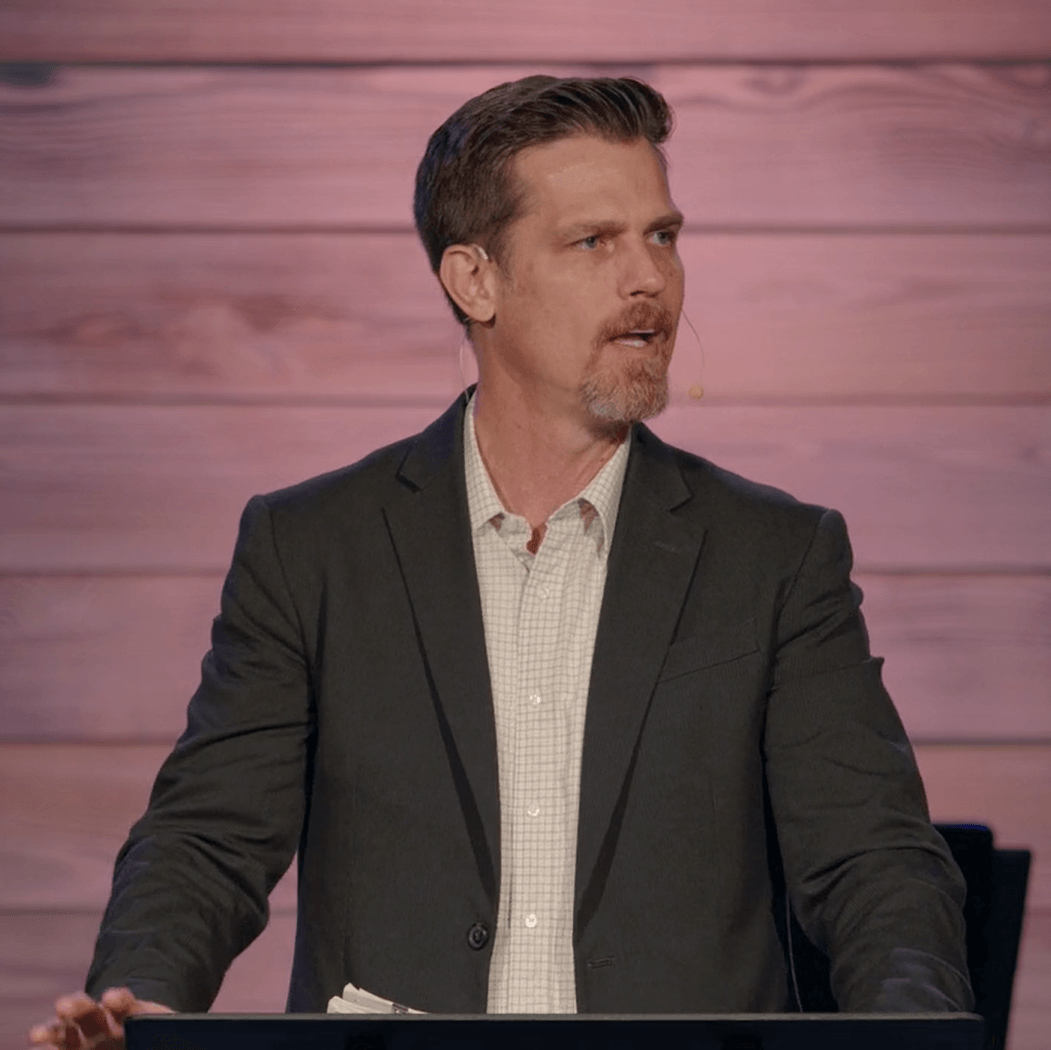
Taught by Dr Tony Caffey
Senior Pastor of Verse By Verse Fellowship




